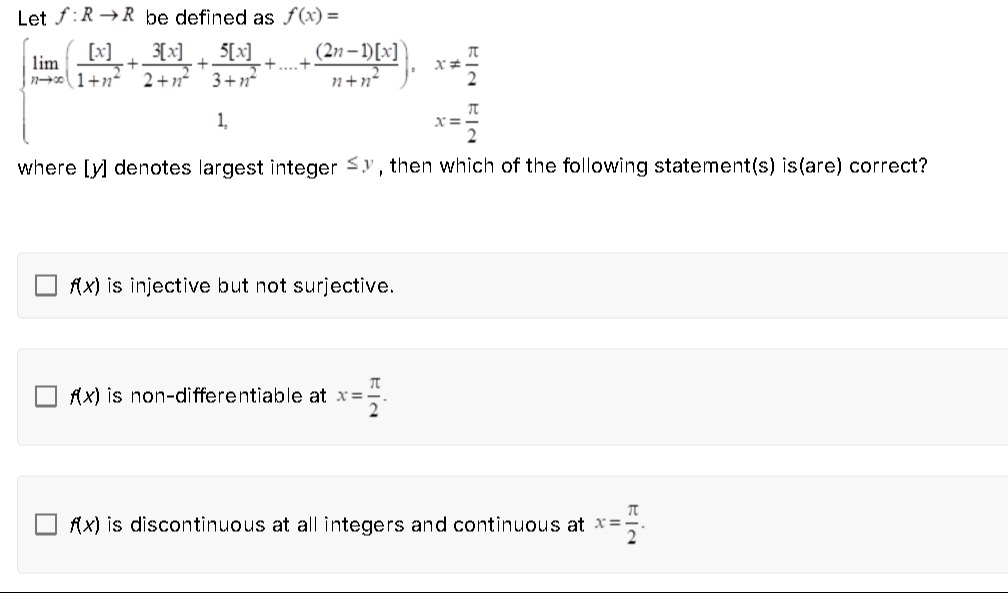Question
Question: Let $f:R \rightarrow R$ be defined as $f(x) = $ $$\begin{cases} \lim_{n\rightarrow \infty} (\frac{[x...
Let f:R→R be defined as f(x)= {limn→∞(1+n2[x]+2+n23[x]+3+n25[x]+....+n+n2(2n−1)[x]),x=2π1,x=2π
where [y] denotes largest integer ≤y, then which of the following statement(s) is(are) correct?

f(x) is injective but not surjective.
f(x) is non-differentiable at x=2π.
f(x) is discontinuous at all integers and continuous at x=2π.
Only Statement 3 is correct.
Solution
Solution:
Given
f(x)={limn→∞(1+n2[x]+2+n23[x]+⋯+n+n2(2n−1)[x]),1,x=2πx=2πwhere [x] is the floor function.
-
Simplification of Limit:
Factor [x] out:
f(x)=[x]⋅n→∞limk=1∑nn2+k2k−1Note that:
k=1∑n(2k−1)=n2.For large n, since n2+k≈n2 (as k is much smaller than n2), we have
k=1∑nn2+k2k−1≈n21⋅k=1∑n(2k−1)=n2n2=1.Therefore, for x=2π:
f(x)=[x].And note that for x=2π, f(x)=1 which is consistent since
[2π]=[1.57]=1.Thus, overall, f(x)=[x] for all x.
-
Verification of Statements:
-
Statement 1: f(x) is injective but not surjective.
The floor function [x] maps any x in an interval [n,n+1) to the same integer n. Hence it is not injective. Though its range is Z (a proper subset of R), it is not surjective onto R; however, the lack of injectivity makes the statement false.
-
Statement 2: f(x) is non-differentiable at x=2π.
For x=2π (approximately 1.57), f(x)=[x]=1 is constant in the surrounding open interval (1,2). Therefore, f(x) is differentiable (derivative = 0) at x=2π. This statement is false.
-
Statement 3: f(x) is discontinuous at all integers and continuous at x=2π.
The floor function is discontinuous at each integer (jump discontinuities) and continuous on intervals between integers. Since 2π lies in (1,2), it is a point of continuity. This statement is true.
-
Thus, only Statement 3 is correct.
Explanation (Minimal):
- The limit simplifies to 1 so that f(x)=[x] for all x.
- Floor function [x] is not injective and is discontinuous at all integers.
- Since 2π is non-integer, f(x)=[x] is continuous there.
- Hence, only Statement 3 is valid.
